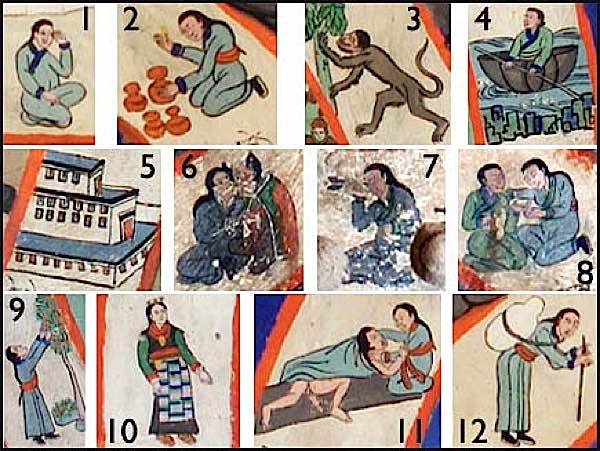We have one hanging over one of our doors.
Great pic my friend!
If the God of Death, holds the wheel of Life,
Then, who holds the wheel of Death and Life???
![]()


"Yet, Buddha went far beyond the scope of this simple statement, teaching us the great Twelve Links of Dependent Co-Arising (see section below) that clearly illustrate the interwoven complexity of interdependence. None of these twelve links has its own “independence” or nature and they are all interdependent and cyclical. The twelfth link circles back to the first.
They are, briefly:
ignorance, mental formation, consciousness, form, six senses, contact, feeling, grasping, clinging, becoming, ageing and death (which links back to ignorance at the beginning)."
Very cool, never heard of this wheel or teaching.
![]()
" 1. Ignorance (avijja) — the condition for the arising of mental formation.
2. Mental Formation (Volitional Formations) (sankhara) — the condition for arising of consciousness.
3. Consciousness (vinnana) — the condition for the arising of name (labels) and form.
4. Name and Form (nama-rupa) — (sometimes translated as mind/body) the condition for the arising of the six senses (perception).
5. The Six Senses (salayatana) — the condition for arising of contact or interactions (the psychological process whereby we interact)
6. Contact (or interaction) (phassa) — the condition for the arising of feeling.
7. Feeling (vedana) — the condition for arising of grasping (wanting)
8. Grasping (wanting or craving) (tanha) — the condition for the arising of “clinging”
9. Clinging (upadana): the condition for the arising of “becoming”.
10. Becoming (bhava) — the condition for the arising of birth.
11. Birth (jati) — the condition for the arising of aging and death.
12. Aging and death (jara-marana) — the condition for arising of ignorance (back to 1)"
" The Cycle of links
Often, the links are described in terms of three groupings:
- Defilements (klesha): in this group ignorance, grasping and clinging
- Actions (karma): in this group mental formation and becoming
- Suffering (dhukka): in this group all the rest, consciousness, name form, the senses, contact, feeling, birth, aging and death.

The twelve links of Dependent Co-Arising are represented on a tangka with 12 symbols (see breakdown below.)
The cycling theme is famously depicted in the Tibetan “Wheel of Life” or “Wheel of Suffering tangkas. These ferocious-looking images feature a great Samsaric beast biting into a wheel. The wheel, on the outside perimeter, has symbolic, pictorial representations of the 12 links:
- Blind woman: first link of ignorance (top of tangka just under the beast’s mouth): blindness represents “ignorance.”
- Potter: second link of mental formations, because the potter forms a shape out of clay (karma) setting into motion.
- Monkey: the third link of consciousness: the monkey is often associated with the mind in Buddhism (monkey mind = unsettled mind), and here represents primitive consciousness forming
- People sailing in a boat: fourth link of the form: the boat represents form and the people represent mental aggregates
- House with six windows: the six windows represent the six senses: eye, ear, nose, tongue, touch, and mind.
- Embracing couple: an amorous pair stands in as a very intimate symbol for “contact” (or interaction). This pleasurable contact leads to “feeling”
- Eye pierced by an arrow: “Feeling” is most graphically represented by a person sitting in pain, holding her eye which has been penetrated by a single arrow. Although all feelings are encompassed in the 7th link, they ultimately all lead to clinging, craving, and pain.
- Drinking alcohol: a person drinks beer, clinging to the pleasures and addictions of “Craving” which arose as a result of “feeling.”
- Monkey reaching for fruit: the monkey again, this time grasping for yummy fruit, representing “Grasping” or “wanting.”
- A pregnant woman: represents “becoming” as she is just about to give birth.
- A mother with child: a naked woman nursing a child, graphically stands in for “Birth”, which ultimately, in a short time, leads to aging and dying and death.
- A dying person slumped on a rock: the loneliness of dying and death. Ultimately, in death, ignorance is reborn, and the cycle beings again."
"
Very educational, thank you @_Barry !
I’ve recommended David Nichtern’s book about this topic for its relevance for today’s world. It’s worth a read.


